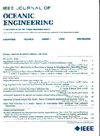水下机器人中基于声纳的深度学习:概述,鲁棒性和挑战
IF 5.3
2区 工程技术
Q1 ENGINEERING, CIVIL
引用次数: 0
摘要
随着人们对水下探测和监测的兴趣日益浓厚,自主水下航行器变得必不可少。最近对车载深度学习(DL)的兴趣依赖于高效和准确的基于视觉的深度学习模型,它具有先进的实时环境交互能力。然而,声呐在水下环境中的主要应用,其特点是训练数据有限和固有噪声,对模型的鲁棒性提出了挑战。这种自主性的提高引起了在水下作业中部署这种模型的安全问题,可能会导致危险情况。本文旨在提供基于声纳的深度学习在鲁棒性范围内的第一个全面概述。它研究了基于声纳的深度学习感知任务模型,如分类、目标检测、分割、同时定位和映射。此外,本文还系统化了基于声纳的最新数据集、模拟器和鲁棒性方法,如神经网络验证、分布外和对抗性攻击。本文强调了基于声纳的深度学习研究缺乏鲁棒性,并提出了未来的研究途径,特别是建立基于声纳的基线数据集并弥合模拟与现实之间的差距。本文章由计算机程序翻译,如有差异,请以英文原文为准。
Sonar-Based Deep Learning in Underwater Robotics: Overview, Robustness, and Challenges
With the growing interest in underwater exploration and monitoring, autonomous underwater vehicles have become essential. The recent interest in onboard deep learning (DL) has advanced real-time environmental interaction capabilities relying on efficient and accurate vision-based DL models. However, the predominant use of sonar in underwater environments, characterized by limited training data and inherent noise, poses challenges to model robustness. This autonomy improvement raises safety concerns for deploying such models during underwater operations, potentially leading to hazardous situations. This article aims to provide the first comprehensive overview of sonar-based DL under the scope of robustness. It studies sonar-based DL perception task models, such as classification, object detection, segmentation, and simultaneous localization and mapping. Furthermore, this article systematizes sonar-based state-of-the-art data sets, simulators, and robustness methods, such as neural network verification, out-of-distribution, and adversarial attacks. This article highlights the lack of robustness in sonar-based DL research and suggests future research pathways, notably establishing a baseline sonar-based data set and bridging the simulation-to-reality gap.
求助全文
通过发布文献求助,成功后即可免费获取论文全文。
去求助
来源期刊

IEEE Journal of Oceanic Engineering
工程技术-工程:大洋
CiteScore
9.60
自引率
12.20%
发文量
86
审稿时长
12 months
期刊介绍:
The IEEE Journal of Oceanic Engineering (ISSN 0364-9059) is the online-only quarterly publication of the IEEE Oceanic Engineering Society (IEEE OES). The scope of the Journal is the field of interest of the IEEE OES, which encompasses all aspects of science, engineering, and technology that address research, development, and operations pertaining to all bodies of water. This includes the creation of new capabilities and technologies from concept design through prototypes, testing, and operational systems to sense, explore, understand, develop, use, and responsibly manage natural resources.
 求助内容:
求助内容: 应助结果提醒方式:
应助结果提醒方式:


